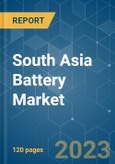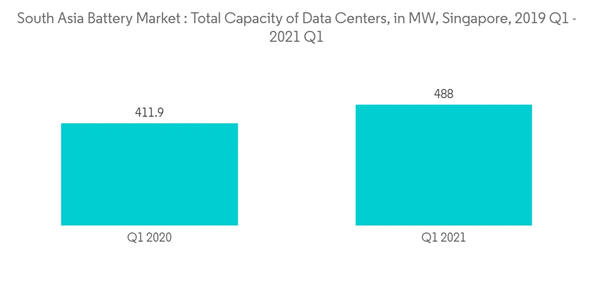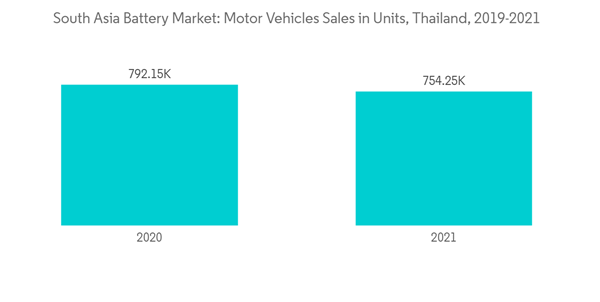The South Asia Battery market is expected to witness a CAGR of more than 10.2% over the forecast period.
The market was negatively impacted by COVID-19. However, it has now reached pre-pandemic levels.
This product will be delivered within 2 business days.
The market was negatively impacted by COVID-19. However, it has now reached pre-pandemic levels.
Key Highlights
- Factors, such as the rapid adoption of the electric vehicle, due to the declining prices, mainly fostered by the declining price of lithium-ion batteries and the increasing demand for data centers in the region, are expected to drive the market studied.
- However, on the flip side, the region has less than 2% battery energy storage systems in comparison to the global scale battery energy storage system. Thus, less demand for energy storage systems is expected to restrain the market during the forecast period.
- The material handling industry is shifting toward li-ion batteries, as li-ion batteries provide higher efficiency compared to lead-acid batteries. Thus, this is expected to provide a great opportunity for Li-ion batteries.
- Thailand has a significant market share owing to the increasing demand from the automotive, data center, and other end-user sectors.
South Asia Battery Market Trends
Data Centers Segment to Dominate the Market
- The demand for data centers is growing at a rapid pace on account of the exponential growth of data from the heavy use of technology. Singapore is preferred by data center operators for the speed at which data is transmitted in the country. The country offers support from the infrastructure around the sub-sea fiber network, which was provided very early on at the cusp of the data center evolution in the Asia-Pacific region.
- Singapore is one of the major financial cities in Asia-Pacific that serves emerging markets in India and South Asia, which makes the city a natural colocation hub. The country is witnessing robust growth in data center infrastructure, which is likely to drive the battery market in the near future.
- According to CBRE Group, Singapore's data centers have increased their capacity to 488 megawatts in the first quarter of 2021, making it one of the leading data center hubs in Asia. During the COVID-19 pandemic, there was a surge in demand for data storage and capacity.
- Various private players have announced their technologies and investments in various types of battery cells in the country. For instance, in May 2022, India-based start-up, Nordische Technologies, launched an Aluminium-Graphene pouch cell battery for consumer electronics, gadgets, and future EV technology in association with the Central Institute of Petrochemicals Engineering and Technology (CIPET), Bengaluru. Thus, such upcoming technologies are likely to drive the battery market in India during the forecast period.
- With the integration of artificial intelligence in various segments such as automobiles, industries, etc., the need to establish data centers is expected to grow in the region, which can foster the increase in demand for batteries for backup purposes in data centers.
- Furthermore, with the increase in penetration of 4G/5G, the speed with which data is transferred over the network has made everyone increasingly opt for internet services. The demand for data centers to store crucial data is increasing, and the trend is expected to continue during the forecast period, providing an opportunity for companies to invest heavily in data centers, which can push the demand for lead-acid and majorly lithium-ion batteries in the regions.
Thailand to have Significant Market Share
- Thailand accounts for a significant share of the market, following India, and this trend is expected to continue in the coming years as well, owing to the increasing demand from the automotive, data center, and telecom sectors.
- Thailand provides great investment potential for the automotive sector. The country has a leading automotive production base in the Association of South Asian Nations. Over a period of 50 years, the country has developed from an assembler of auto components into a top automotive manufacturing and export hub.
- In 2021, Thailand's sales were 754,254 units of motor vehicles to become one of the top performers in the global automotive market. Hence, this is expected to increase the demand for automotive batteries in the country during the forecast period.
- Moreover, the Thailand government is focusing on incentivizing eco-car makers to launch more eco EVs, especially the hybrid type. These eco EVs will also get an excise tax reduction, like other EV models, making retail prices more affordable. This, in turn, is expected to create a significant amount of opportunities for both EV and battery manufacturers in the coming years.
- The government has also planned its business module under the Thailand 4.0 Programme. This program will help increase new technologies, such as cloud computing, interactive media, big data, and the internet of things.
- In August 2022, Bridge Data Centres acquired a data center in Bangkok as part of its expansion into Thailand. The newly acquired BKK01 facility is now operating at 450kw and has a floor size of roughly 6,500 sqm (70,000 sq ft), with the remaining space scheduled to be outfitted to accommodate an additional 5MW IT capacity load.
- Therefore, factors such as upcoming data centers and an expected increase in automobile production in the coming years are expected to drive the battery market in Thailand during the forecast period.
South Asia Battery Market Competitor Analysis
The South Asian battery market is partially fragmented. Some of the key players in this market (not in a particular order) include BYD Co. Ltd, C&D Technologies Inc., Exide Industries Limited, GS Yuasa Corporation, and LG Chem Ltd.Additional benefits of purchasing the report:
- The market estimate (ME) sheet in Excel format
- 3 months of analyst support
This product will be delivered within 2 business days.
Table of Contents
1 INTRODUCTION
4 MARKET OVERVIEW
5 MARKET SEGMENTATION AND ANALYSIS
6 COMPETITIVE LANDSCAPE
Companies Mentioned (Partial List)
A selection of companies mentioned in this report includes, but is not limited to:
- BYD Co. Ltd
- C&D Technologies Inc.
- Exide Industries Ltd
- GS Yuasa Corporation
- LG Chem Ltd
- Panasonic Corporation
- Samsung SDI Co. Ltd
- Leoch International Technology Limited
- ENERSYS
- Amara Raja Batteries Ltd
Methodology

LOADING...










